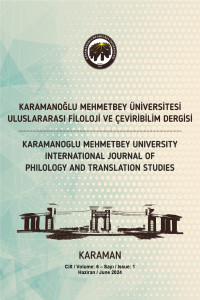Öz
Makine çevirisinin yaygınlaşması ve nöral makine çevirisinin gelişmesi edebiyat çevirisi de dahil olmak üzere çeşitli alanlarda değişimleri beraberinde getirmiştir. Makine çevirisine ilişkin algının incelendiği alımlama çalışmaları halihazırda az sayıdayken çevirmenin makine çevirisine ilişkin alımlamasını değerlendiren çalışmalar da çok kısıtlıdır. Bu çalışmanın amacı çevirmenlerin makine çevirisine dair beklentilerini Afrikalı Amerikalı yazar James Baldwin’in Tell Me How Long The Train’s Been Gone (1970) başlıklı romanının Türkçe çevirileri aracılığıyla ölçümlemektir. James Baldwin’in bu eseri okurun metinle doğrudan özdeşlik kurmasını sağlayan birinci tekil şahıs bakışıyla kalem alınmış olup çevirmenlerin makine çevirisi alımlamasına odaklanan bir çalışmada incelenebilecek çeşitli çeviri kategorilerine ilişkin veri sağlamaktadır. Bu çalışmada da argo çevirisinden şiir çevirisine kadar farklı çeviri kategorilerinden ifadeler eserin iki insan çevirisi (Balamir, 1973; Cenkçiler, 2007) ile makine çevirisinden (DeepL) örnekler üzerinden ele alınacaktır. Alımlama odaklı inceleme kapsamında, uzun cümle çevirisi, kısa cümle çevirisi, deyimsel ifade çevirisi, argo çevirisi ve şiirsel ifade çevirisi içerikli beş kategori belirlenmiş, yirmi beş (25) çevirmenin seçilen kesitlerin hangisinin makine çevirisi olduğunu tahmin etmesi ve tahminlerine dair nedenler belirtmesi istenmiştir. Çalışmada kullanılan veriler yapılandırılmış ve yarı yapılandırılmış sorulardan oluşan anket ile elde edilmiştir. Veri analizi için tematik analiz kullanılmış, katılımcı çevirmenlerin verdiği cevaplar ilgili çeviri kesitiyle ilişkilendirilerek bulgular elde edilmiştir. Çalışma sonucunda çevirmenlerin özellikle şiir kategorisinde makine çevirisi alımlamasında başarı gösterdikleri ancak kültüre özgü anlamsal değişkenler içeren argo ve deyim çevirilerinde görece sınırlı alımlamaya sahip oldukları gözlemlenmiştir.
Anahtar Kelimeler
çeviri alımlaması makine çevirisi James Baldwin çevirmen alımlaması
Etik Beyan
Bu çalışma, Ezgi KAYADİBİNLİ tarafından Dr. Öğr. Üyesi Göksenin ABDAL danışmanlığında halen yazılmakta olan "James Baldwin’i Makine Çevirisiyle Okumak: Çevirmenlerin Makine Çevirisi Alımlaması" adlı tezden üretilmiştir.
Kaynakça
- Baldwin, J. (1998). Tell Me How Long the Train's Been Gone (First Reprint edition). Vintage. (Original work published 1968).
- Baldwin, J. (1973). Ne Zaman Gitti Tren (O. Balamir, Çev.; 1. baskı). Sander Yayınları.
- Baldwin, J. (2019). Ne Zaman Gitti Tren (D. Cenkçiler, Çev.; 2. baskı). Yapı Kredi Yayınları.
- Barut, E. (2022). “İstatistiksel makine çevirisi ile nöral makine çevirisinin dilbilimsel parametrelerle karşılaştırılması: Google Translate.” Akdeniz Havzası ve Afrika Medeniyetleri Dergisi, 4(1), 103-118.
- Brems, E., & Ramos Pinto, S. (2013). “Reception and translation.” Handbook of translation studies, 4(1), 142-147.
- Chesterman, A. (2007). “Bridge concepts in translation sociology.” Benjamins translation library, 74, 171.
- DeepL (2022). Why DeepL? Erişim Adresi: https://www.deepl.com/en/whydeepl Erişim Tarihi: 13 Ocak 2024.
- Doherty, S., O’Brien, S., & Carl, M. (2010). “Eye Tracking as an MT Evaluation Technique.” Machine Translation, 24, 1-13.
- Federici, F. M. (2018a). “A mapping exercise: Eye tracking, translation, and multi-sensorial data.” Instituto de Engenharia de Sistemas e Computadores, Investigação e Desenvolvimento em Lisboa (INESC-ID), Lisbon, Portekiz. 6 Nisan.
- Federici, F. M. (2018b). “Tracking eyes and chasing comprehension: From english as lingua franca to english as pivot language to access crucial information.” In the Biennial Conference of the Associazione Italiana di Anglistica [Italian Association of English Studies], University of Macerata, İtalya (pp. 18-19). Gambier, Y. (2009). “Challenges in research on audiovisual translation.” Translation research projects, 2, 17-25.
- Guerberof-Arenas, A., & Toral, A. (2022). “Creativity in translation: Machine translation as a constraint for literary texts.” Translation Spaces, 11(2), 184-212.
- Guerberof-Arenas, A., & Toral, A. (2024). “To be or not to be: A translation reception study of a literary text translated into Dutch and Catalan using machine translation.” Target, 36(2), 215-244.
- Hu, K., O’Brien, S., & Kenny, D. (2020). “A reception study of machine translated subtitles for MOOCs.” Perspectives, 28(4), 521-538.
- Hutchins, J. (2010). “Machine translation: A concise history.” Journal of Translation Studies, 13 (1–2), 29–70. Kovačič, I. (1995). “Reception of subtitles: The non-existent ideal viewer.” Translatio, 14 (3–4): 376–383.
- Orrego-Carmona, D. (2018). “Audiovisual translation and audience reception.” The Routledge handbook of audiovisual translation, 367-382. New York: Routledge.
- Şahin, M. (2015). “Çevirmen adaylarının gözünden İngilizce-Türkçe bilgisayar çevirisi ve bilgisayar destekli çeviri: Google deneyi.” Çeviribilim ve Uygulamaları Dergisi, 21, 43-60.
- Walker, C. (2021). “Investigating how we read translations: A call to action for experimental studies of translation reception.” Cognitive Linguistic Studies, 8(2), 482-512.
- Wang, H., Wu, H., He, Z., Huang, L., & Church, K. W. (2022). “Progress in machine translation.” Engineering, 18, 143-153.
Öz
The spread of machine translation and the development of neural machine translation have brought about changes in various fields, including literary translation. While reception studies examining the perception of machine translation are still scarce, there is also a very limited number of studies evaluating the translators’ reception of machine translation. This study aims to estimate translators' expectations of machine translation through the Turkish translations of the novel Tell Me How Long The Train's Been Gone (1970) by African American writer James Baldwin. In the analysis, expressions from different translation categories ranging from slang to poetry will be analyzed through examples from two human translations of the novel (1973, 2007) and its raw machine translation (DeepL). Within the scope of the reception-oriented analysis, five categories including long sentences, short sentences, idiomatic expressions, slangs and poetic expressions were identified, and twenty-five (25) translators were asked to guess which of the selected passages were translated by machine and to give reasons for their guesses. The data used in the study were obtained through a questionnaire consisting of structured and semi-structured questions. Thematic analysis was used for data analysis, and findings were obtained by associating the answers given by the participant translators with the relevant translation segment. As a result, it was revealed that translators' uptake of machine translation varied significantly according to the specified translation categories.
Anahtar Kelimeler
translation reception machine translation James Baldwin translator reception
Kaynakça
- Baldwin, J. (1998). Tell Me How Long the Train's Been Gone (First Reprint edition). Vintage. (Original work published 1968).
- Baldwin, J. (1973). Ne Zaman Gitti Tren (O. Balamir, Çev.; 1. baskı). Sander Yayınları.
- Baldwin, J. (2019). Ne Zaman Gitti Tren (D. Cenkçiler, Çev.; 2. baskı). Yapı Kredi Yayınları.
- Barut, E. (2022). “İstatistiksel makine çevirisi ile nöral makine çevirisinin dilbilimsel parametrelerle karşılaştırılması: Google Translate.” Akdeniz Havzası ve Afrika Medeniyetleri Dergisi, 4(1), 103-118.
- Brems, E., & Ramos Pinto, S. (2013). “Reception and translation.” Handbook of translation studies, 4(1), 142-147.
- Chesterman, A. (2007). “Bridge concepts in translation sociology.” Benjamins translation library, 74, 171.
- DeepL (2022). Why DeepL? Erişim Adresi: https://www.deepl.com/en/whydeepl Erişim Tarihi: 13 Ocak 2024.
- Doherty, S., O’Brien, S., & Carl, M. (2010). “Eye Tracking as an MT Evaluation Technique.” Machine Translation, 24, 1-13.
- Federici, F. M. (2018a). “A mapping exercise: Eye tracking, translation, and multi-sensorial data.” Instituto de Engenharia de Sistemas e Computadores, Investigação e Desenvolvimento em Lisboa (INESC-ID), Lisbon, Portekiz. 6 Nisan.
- Federici, F. M. (2018b). “Tracking eyes and chasing comprehension: From english as lingua franca to english as pivot language to access crucial information.” In the Biennial Conference of the Associazione Italiana di Anglistica [Italian Association of English Studies], University of Macerata, İtalya (pp. 18-19). Gambier, Y. (2009). “Challenges in research on audiovisual translation.” Translation research projects, 2, 17-25.
- Guerberof-Arenas, A., & Toral, A. (2022). “Creativity in translation: Machine translation as a constraint for literary texts.” Translation Spaces, 11(2), 184-212.
- Guerberof-Arenas, A., & Toral, A. (2024). “To be or not to be: A translation reception study of a literary text translated into Dutch and Catalan using machine translation.” Target, 36(2), 215-244.
- Hu, K., O’Brien, S., & Kenny, D. (2020). “A reception study of machine translated subtitles for MOOCs.” Perspectives, 28(4), 521-538.
- Hutchins, J. (2010). “Machine translation: A concise history.” Journal of Translation Studies, 13 (1–2), 29–70. Kovačič, I. (1995). “Reception of subtitles: The non-existent ideal viewer.” Translatio, 14 (3–4): 376–383.
- Orrego-Carmona, D. (2018). “Audiovisual translation and audience reception.” The Routledge handbook of audiovisual translation, 367-382. New York: Routledge.
- Şahin, M. (2015). “Çevirmen adaylarının gözünden İngilizce-Türkçe bilgisayar çevirisi ve bilgisayar destekli çeviri: Google deneyi.” Çeviribilim ve Uygulamaları Dergisi, 21, 43-60.
- Walker, C. (2021). “Investigating how we read translations: A call to action for experimental studies of translation reception.” Cognitive Linguistic Studies, 8(2), 482-512.
- Wang, H., Wu, H., He, Z., Huang, L., & Church, K. W. (2022). “Progress in machine translation.” Engineering, 18, 143-153.
Ayrıntılar
| Birincil Dil | Türkçe |
|---|---|
| Konular | Edebi Çalışmalar (Diğer) |
| Bölüm | Araştırma Makaleleri |
| Yazarlar | |
| Yayımlanma Tarihi | 30 Haziran 2024 |
| Gönderilme Tarihi | 5 Haziran 2024 |
| Kabul Tarihi | 19 Haziran 2024 |
| Yayımlandığı Sayı | Yıl 2024 Cilt: 6 Sayı: 1 |
422x119
Articles published in this journal are licensed under Creative Commons Attribution 4.0 International license. This journal does not charge APCs or submission charges. Articles published in this journal are permanently free for everyone to read, download, copy, distribute, print, search and link to the full texts of these articles. |












